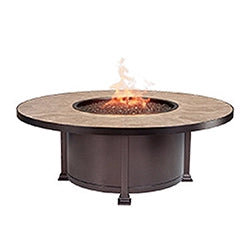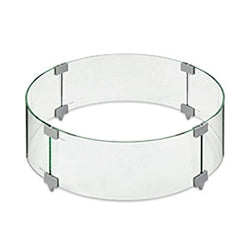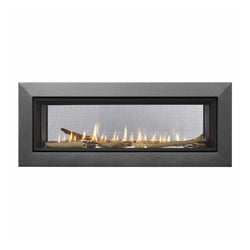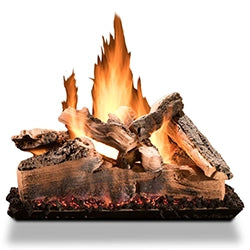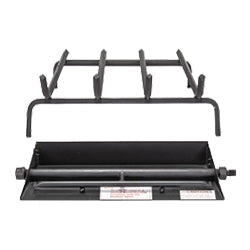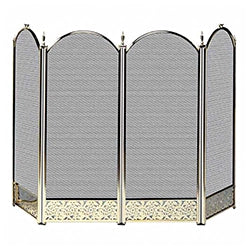A fire pit kit is an excellent patio design solution for any number of reasons. Maybe you’re a backyard artist wanting to design a unique fire pit experience, or maybe you just want to save some cash without skimping on the quality of your cozy firepit experience. Regardless of the reasons, anyone considering this approach to outdoor space cozification needs to know the benefits, options, and inherent risks in purchasing a kit instead of a prefabricated fire pit.
Plus, if you’ve already googled fire pit kits, you won’t be surprised to learn there are different types of fire pit kits: surrounds, drop-in kits, fuel kits, ignition kits… the list goes on. There’s nothing worse than setting your budget, finding the right kit at your local big box store, and only realizing when you open the box that you’ve only purchased part of a working fire pit.
Well, we’ve spent years learning the best (and worst) fire pit kit ideas and practices when it comes to selection and installation. And today, you’ll get our tips and professional insights on fire pit kit types, components, materials, costs, installation, and more. All to make sure you have all the information to decide whether you want to install your fire pit from a kit. And if so, to arm you to get everything done right, beautifully, and safely the first time.
Looking for a Comprehensive Guide to Buying Fire Pits, we've got you covered!
Fire Pit Kit Overview
- Safety comes first: Always check local regulations before purchasing or installing a fire pit, and maintain proper clearance from structures and overhanging trees.
- Material selection matters: The right materials ensure durability, weather resistance, and complement your outdoor aesthetic.
- Preparation is key: Proper site selection and ground preparation prevent future problems and extend the life of your fire pit.
- Fuel type determines experience: Wood, propane, and natural gas each offer different ambiance, convenience, and maintenance requirements.
- Understand Costs & DIY with Caution: Costs can vary greatly, and professional installers can help you avoid painful, unexpected costs in the future.

Fire Pit Kit Basics
Outdoor fire pits all share some general components. The durable outer structure that holds everything together, commonly made from stone, concrete, brick, or metal. An inner liner or ring that protects the outer structure from your fire’s direct, intense heat. Then gas fire pits–whether they’re fueled by natural gas, propane, or ethanol–also have ignition, burner, fuel lines, and venting systems to make it operate safely and efficiently.
The trick is that not every fire pit kit comes with all of these components, and there are also times when you want to buy those pieces separately. For instance, our fire pit drop-in kits give you the safety and efficiency of high-quality fuel and heat management systems that can be dropped into the fire pit structure of your choice… giving you a nice level of customizability while ensuring quality where you absolutely need it.
Types of Fire Pit Kits
There’s a lot of of options and styles you can consider when shopping for a fire pit kit. But there are a handful of types that you’ll generally find to be most common, so we’ll cover those first.

Wood-Burning Fire Pit Kits
Wood-burning fire pit kits–classic and timeless for those seeking that authentic campfire experience. The crackling sounds, dancing flames, and unmistakable aroma of burning wood create an ambiance that’s hard to replicate. They’re also often among the less expensive options you can find because there aren’t a ton of moving or complex parts to them.
These kits usually just include a metal ring insert and decorative stone or concrete blocks for the outer structure. Most wood-burning kits have an open design, allowing you and your guests the ability to gather around it, enjoying 360-degree views of the fire.
The Drawbacks: wood-burning fire pits do require more maintenance. You’ll need to clean out ash regularly and store dry wood. Depending no the type and quality of your fire wood, these fire pits can create some serious smoke (which will undoubtedly follow one unfortunate person). And in some areas, wood fire pits face seasonal restrictions due to air quality concerns.
If you love the idea of that real-wood backyard fire experience, check out these wood burning fire pit ideas to create stunning style.

Gas Fire Pit Kits
Looking for a convenient fire experience that’s as easy as pushing a button? Gas fire pit kits may be perfect for you. You’ll first need to choose which fuel type you’re interested in: natural gas, propane, or ethanol. Each gas fire pit fuel has its benefits and potential drawbacks.
- Natural gas: connects to your home’s existing natural gas line, so you don’t have to constantly worry whether your tank is empty.
- Propane: propane fire pit kits come with easy-to-use propane tank connections, and often with built-in spaces to hide the tank visually.
- Ethanol: these kits come with similar parts to a propane kit, but burns a naturally-derived ethanol fuel. The maximum heat output is generally lower, but still warm enough for nearly any outdoor gathering.
One great thing about gas fire pit kits? When you’re ready for some time around the ole fire pit, no prep is necessary. Instant ambiance without the smoke, ash, or cleanup of wood fires. I also love that the flames are adjustable and consistent, so they’re that much better for entertainment areas where you want low-effort, reliable ambiance without having to constantly tend it.
Recent market research suggests that about 78% of first-time buyers prefer propane fire pits specifically for their ease of use. And I have to say… after wrestling with damp wood and smoky fires for years, I’m a gas fir pit convert. We use it much more often, meaning more cozy outdoor time for my family.
Most gas kits often include:
- Burner and control system
- Fire media (like lava rock or glass)
- Decorative exterior materials
- Protective covering
The Drawbacks: your monthly cost for gas needs to be accounted for. Plus, the inner systems need to be checked, maintained, and replaced fairly regularly. It’s critical not just for functionality, but for safety.

Fire Table Kits
Maybe you’re looking for both function and style. Well, fire table kits combine the warmth of a fire pit with the utility of a table. These are almost exclusively made to be gas-fueled, featuring elevated designs which typically feature a burner set within a table-height surface, surrounded by a ledge wide enough for drinks or plates.
You can find fire tables in all shapes and styles–round, square, rectangular, and more. And in materials from lightweight aluminum to weather-resistant poly lumber or natural stone.
They typically stand between 20-30 inches high, making them perfect companions for standard patio furniture. And they create an integrated look that elevates any outdoor design.

In-Ground Fire Pit Kits
For a sleeker, more minimalist approach, in-ground fire pit kits offer a solution that sits flush with your patio or yard. These kits are designed to be installed below grade, creating a streamlined look where the fire appears to rise directly from the ground.
In-ground designs are available for both wood and gas fuels, though gas models tend to be more common due to their simpler installation requirements.
The Starfire Direct team recently installed an in-ground fire pit for a local neighbor. The customer had considered installing it themselves, but the in-ground design ended up requiring more extensive excavation than above-ground options. But in the end, the results were well worth it. The modern, low profile created an unobstructed view across their patio, creating an outdoor gathering space that felt larger and more integrated.
In-ground fire pit kits typically include:
- Liner or containment system
- Drainage components
- Burner apparatus (for gas models)
- Edge materials
The Drawbacks: In-ground pits tend to be more expensive and time-intensive. You need careful planning for drainage to prevent water accumulation, but when properly installed, you get a striking focal point that doesn’t dominate your outdoor design.

Fire Pit Kit Key Features to Look For
Materials, size, shape, heat output, and safety features all have a huge impact on your fire pit’s appearance, performance, resilience, and longevity.
Construction Materials
- Steel Fire Pits: These lightweight, often portable options provide excellent heat radiation and come in countless designs. Look for high-gauge steel with heat-resistant coatings to prevent rusting and deterioration. I’ve found that steel pits with at least 2mm thickness stand up best to repeated heating and cooling cycles.
- Stone and Concrete: These materials offer superior durability and weather resistance. They retain heat effectively and complement most landscape designs. Stone kits typically use modular blocks specifically designed for heat resistance.
- Brick Fire Pits: Classic red brick creates a timeless look, but ensure you’re using fire-rated bricks for the interior. Standard bricks can absorb moisture and crack when exposed to intense heat—a lesson I learned the hard way with my first DIY attempt!
For any masonry fire pit, check that the kit includes (or recommends) appropriate high-temperature adhesive. Regular concrete mortar can break down under extreme heat.
Size and Shape Considerations
Make sure you choose your size based both on your available space and how many people will use it.
- 30" diameter: Intimate setting for 2-4 people
- 36" diameter: Comfortable for 4-6 people
- 48"+ diameter: Great for larger gatherings
As for space around your fire pit, you’ll want about 7 feet of clearance from the fire’s edge to the back of your seats. This gives you enough space for comfortable heat, convenient conversation, and safe movement.
What fire pit shape should you choose? Round fire pits let everyone gather around and see everyone else. But square or rectangular designs often fit modern patio or furniture arrangements better.
Heat Output and Fuel Efficiency
Different fire pit designs and fuels produce varying levels of heat output (measured in BTUs). For gas models, look for:
- Small pits (under 30"): 30,000-60,000 BTUs
- Medium pits (30-36"): 60,000-90,000 BTUs
- Large pits (over 36"): 90,000+ BTUs
Wood-burning pits don’t come with BTU ratings, but their size directly impacts how much wood they can hold and how much heat they generate.
Fire pit shoppers in cooler climates often prefer gas models with output of at least 70,000 BTUs or wood pits at least 36" across. This creates enough warmth during evening gatherings.

Fire Pit Safety Features & Accessories
We’re literally playing with fire here, so safety should be one of your main concerns. The National Fire Protection Association reports that outdoor fires cause thousands of home structure fires every year. Proper ventilation is also essential to prevent carbon monoxide buildup.
Protective Screens: Most kits come with a protective screen for safety, especially important for wood-burning models to prevent sparks and embers from escaping.
Wind Guards: Glass wind guards not only protect the flame from being extinguished but also prevent people (especially children) from accidentally reaching into the fire.
Stabilization Features: Ensure the kit includes methods to secure the fire pit, whether through weight, anchoring systems, or proper foundation design.
Heat Shields: For models placed on wooden decks or sensitive surfaces, heat shields protect the underlying area from excessive temperatures.
Auto-Shutoff: Premium gas models often include tilt sensors or timer functions that automatically shut off gas flow in certain circumstances.
Fire Pit Site Selection and Preparation
Just as important as your choice of fire pit is where and how you place it in your outdoor space. Here’s a quick guide on picking a spot that’s beautiful, secure, and safe.
Choose a Safe Location: Safety first! Keep 10-25 feet distance from structures, overhanging trees, or combustible materials. Check your city and neighborhood regulations. Know your local wind and weather patterns–prevailing winds can blow smoke or flames into unfortunate or dangerous areas.
Choose a Convenient Spot: find a spot close to your house to easily bring food/drinks out, but far enough that smoke doesn’t waft inside. Make sure you have access to your fuel source (gas line or food storage), and make sure you’re creating good views–from inside and outside the house.

Fire Pit Kit Ground Preparation and Installation
The long-term success and survival of your fire pit is directly dependent on how well you prepare the area and install your fire pit kit. We’re developing a full, comprehensive guide on this entire process. But for now, here are the most important steps you’ll need to consider and research.
- Measure your space, mark off the area, and level the ground (meticulously)
- Plan for proper drainage and utilities (call 811 - “Call Before You Dig” hotline)
- Lay the Foundation
- Build fire pit structure
- Install gas components (if applicable)
- Add additional components and cosmetic features
- Finish decorating, accessorizing, and arranging your furniture and space
At the end, give your whole space a good, thorough cleaning. For stone or concrete fire pits, I recommend applying a heat-resistant sealer to the exterior (never interior) surfaces. This protects against staining and weather damage.
DIY fire pit kits have increased in popularity by about 27% over the past five years. And many homeowners have learned that the right fire pit kit makes this project accessible even for those with limited construction experience.
Customizing Your Fire Pit
Once your fire pit is chosen and installed, you still have a number of ways to really make it your own–from style to functionality and longevity. That's why fire pit kits are a great way to refresh your outdoor space!
| Decorative Elements | Functional Add-ons | For Extended Usability |
|---|---|---|
| Fire glass (in various colors) | Cooking grates | Lighting (low-voltage landscape lighting) |
| Lava rock or river stones | Spark screens | Weather-resistant storage for wood or tools |
| Ceramic log sets | Protective covers | Heat-reflective backing materials |
| Copper or stainless steel accents | Seating elements like wall caps or bench materials |

Decorative Enhancements
The basic structure of your fire pit is just the beginning—decorative enhancements personalize your fire feature and integrate it with your overall landscape design.
Fire Media Options:
- Lava rock provides a natural, traditional look
- Fire glass adds vibrant color and reflective sparkle
- Ceramic log sets create a wood-fire appearance for gas pits
- River rocks offer a smooth, organic aesthetic
Exterior Finishes:
- Stone veneer can transform basic block kits
- Tile accents add color and pattern
- Metal bands or caps create contemporary appeal
- Custom paint for concrete components (using heat-resistant formulas)
Lighting Integration:
- Under-cap LED lighting illuminates the structure
- Surround lighting highlights the fire pit as a feature
- Color-changing options create dramatic effects
- Solar-powered accents for areas without electrical access
I recently helped a client update their basic contractor-grade fire pit with copper cap pieces and blue fire glass. The transformation was remarkable—from bland to statement piece with just two simple changes.

Functional Add-ons
Beyond aesthetics, consider additions that enhance functionality and enjoyment.
Cooking Accessories:
- Swing-away grill grates for wood pits
- Custom cooking surfaces for gas models
- Rotisserie attachments for serious outdoor cooking
- Adjustable cooking heights for temperature control
Comfort Enhancements:
- Built-in seating walls surrounding the fire pit
- Integrated drink rails or table surfaces
- Heat reflectors to direct warmth toward seating
- Wind guards that protect flames while enhancing views
Convenience Features:
- Wood storage incorporated into the design
- Hidden propane tank compartments
- Remote controls for gas models
- Smart home integration for high-end installations
Weather Protection:
- Retractable covers for quick protection
- Pergolas or partial roofs for rainy climates
- Removable spark screens for windy conditions
One spring, a client specifically requested a fire pit that could double as a table when not in use. We installed a modern hard cover that transforms their fire pit into a functional dining surface within minutes—perfect for their limited patio space. It was an easy way to make their fire pit ready for a beautiful spring!

Budgeting for Your Fire Pit Project
The average cost of a fire pit kit can vary widely–from around a couple hundred dollars up into the thousands. That’s because there’s a similarly wide range of surround materials, styles, and fuel types… all with related preparation, tools, accessory, or installation needs and costs.
| Fire Pit Type | Material Cost | Installation Cost | Ongoing Expenses |
|---|---|---|---|
| Wood-Burning Stone Kit | $500-1,000 | $200-500 DIY | $75-150/yr for wood |
| Propane Fire Table | $800-2,000 | $100-300 DIY | $100-200/yr for propane |
| Natural Gas Built-In | $1,500-3,000 | $800-1,500 Professional | $50-150/yr in gas costs |
| Custom Masonry | $2,000-5,000+ | $1,000-2,500 Professional | Varies by fuel type |
Cost Breakdown by Type
Making a realistic budget for your fire pit kit installation starts with knowing the costs of each different type. Each type is unique, with its own strengths, drawbacks, and long-term financial implications.
Wood-Burning Kit Costs:
- Basic stone ring kits: $300-$700
- Premium stone or brick kits: $700-$1,500
- Installation materials: $100-$300
- Tools (if not already owned): $50-$200
Gas Fire Pit Expenses:
- Entry-level gas kits: $500-$1,000
- Mid-range models: $1,000-$2,500
- High-end designer units: $2,500-$5,000+
- Gas line installation (if needed): $300-$800
- Professional installation (recommended): $500-$1,500
Fire Table Investment:
- Basic models: $700-$1,500
- Premium designs: $1,500-$3,000
- Custom built-in options: $3,000-$7,000+
Almost a decade back, I helped a neighbor install their own fire pit. She budgeted $600 but ended up spending nearly $950 after we had to add proper drainage, chose to upgrade to a better stone, and picked out a spark screen (that wasn’t included in the base kit). Like any construction project, these costs can escalate quickly. I recommend building in a 20% contingency for your budget for those unexpected costs.
Value-Adding Features for Your Fire Pit Kit
The fire pit and fuel system are obviously your main cost considerations. But there are a lot of useful upgrades that can add significant extra value relative to their cost, enhancing both enjoyment and potential return on investment. Unfortunately, there are also accessories that you’ll want to think twice about… simply because they don’t add that much value overall.
High-Value Additions:
- Glass wind guards ($200-400): Protect flames and improve appearance
- Quality covers ($75-200): Significantly extend the life of your fire pit
- Adjustable flame controls ($100-300): Enhance usability and comfort
- Seating integration ($500-1,500): Creates a cohesive outdoor room
- Lighting elements ($150-400): Extend usability into evening hours
Features with Less Return on Investment:
- Overly complex burner patterns
- Extremely high BTU ratings beyond practical needs
- Elaborate electronic controls susceptible to weather damage
- Highly trendy designs that may quickly look dated
Studies by real estate professionals have shown that well-designed outdoor spaces can increase property value by around 15%, with fire features being particularly desirable selling points. Our advice? Invest in quality for the core components, then you can be more conservative with trendy accessories that can be easily changed down the line.

DIY vs. Professional Installation
Deciding whether to install your fire pit yourself or hire a professional significantly impacts your budget.
| DIY | Hiring Professionals |
|---|---|
|
Advantages: - Cost savings of $500-1,500 on installation labor - Personal satisfaction of creating your own outdoor feature - Flexibility to work at your own pace - Ability to make adjustments during the process |
Benefits: - Expertise in proper construction techniques Faster completion (typically 1-2 days versus 2-4 weekends) - Warranty on workmanship - Proper handling of gas connections and safety features - Knowledge of local codes and permit requirements |
|
Best Candidates for DIY: - Basic wood-burning stone kits - Propane fire tables requiring minimal assembly - Simple prefabricated units with clear instructions - Homeowners with basic masonry or construction experience |
Projects Better Left to Professionals: - Natural gas installations requiring gas line work - Custom masonry fire pits with complex designs - Installations on sloped terrain needing significant grading - Projects requiring electrical work for ignition systems |
DIY fire pit kits have increased in popularity by 27% over the past five years, making them more accessible to homeowners with moderate skills. However, I always recommend professional installation for any project involving gas lines or complex electrical components.
Long-Term Cost Considerations
The true cost of a fire pit extends beyond the initial purchase and installation expenses.
Ongoing Expenses by Fuel Type:
- Wood: $75-200 annually for quality firewood
- Propane: $100-300 annually depending on usage frequency
- Natural Gas: Typically $75-150 annually added to gas bills
Maintenance Costs to Consider:
- Replacement of fire media every 2-3 years: $50-200
- Protective covers: $75-200 every 3-5 years
- Ignition system repairs: $100-300 when needed
- Refinishing or resealing: $50-200 every 2-5 years
Value of Proper Planning:
- Investing in quality materials upfront may double initial costs but can triple the lifespan
- Proper site preparation adds 10-15% to initial costs but prevents expensive repairs
- Professional design consultation ($300-500) often saves thousands in mistakes
My neighbor opted for a budget fire pit kit that needed replacement after just three seasons, while my higher-quality investment is still going strong after seven years with only minor maintenance. Sometimes the least expensive option costs more in the long run.

Final Thoughts: Your Perfect Fire Pit Space
Choosing the best fire pit kit is just one part of your whole cozy outdoor space vision. Start by imagining the experiences you want to create in your outdoor space, from quiet evenings of reflection to lively gatherings of friends and family. And for all of that, a well-designed fire pit is the heart of new backyard experiences.
So, whether you choose a simple DIY kit or invest in a custom built-in feature, your time and resources spent are investments that will pay off in enjoyment for years to come. So plan it, install it, maintain it… and your fire pit will be far more than just an outdoor feature. It will be a comfy gathering place for creating memories.
So grab your measuring tape, check your local codes, and make your dream space happen. As always, we’re here to answer your questions and find your perfect fire pit kit.







